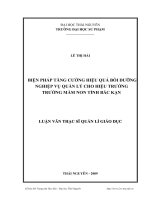Landslide risk assessment bac kan
Bạn đang xem bản rút gọn của tài liệu. Xem và tải ngay bản đầy đủ của tài liệu tại đây (12.23 MB, 46 trang )
Landslide risk assessment
The case study of landslide disaster vulnerability assessment in Vietnam
Dr. Nguyen Thi Thi Ha
グググ ググ ググ ハハ
Content of lecture
1.
Introduction
2.
Approach and methods
3.
Results and Discussion
4.
Conclusion
5.
Future works
Seeking dead people
1. Introduction
1.1. Concept of Landslide risk assessment
•
About 10 landslide disasters per year affecting residential lives,
development and municipal infrastructure
•
Landslide accompanied with heavy rain/floods
Before: usually occur in raining season (July – September); Now:
in the whole year
•
Consequences have included: injury, fatality; damage to property
and infrastructure; environmental impacts; increased
development costs
Damaged an industrial factory
Specific Risk is the expected degree of loss (experienced by a given element) due to a particular natural phenomenon (Varnes, 1984). It is
considered as the product of hazard and vulnerability, eg:
Rs = H × V
Rt = sum (E × Rs) = sum(E × H × V)
Risk (R)
Specific Risk, (RS)
Vulnerability (V)
Damage (D)
Element (E)
Hazard (H)
Probability (P)
Magnitude (M)
1.2. Study area
Bac Kan Province ( ググググ ) located in the Northern mountainous area of
Vietnam
Geographical features:
The name Bac Kan is ググ , total area of 4,859.4 km
Its terrain has the highest altitude in the Northeast
2
mountainous region, varies from 1,640 m (highest point in
Khe Thuong mountain) to the lowest point of 40 m in Cho
Moi.
There are numerous rivers and streams flowing through
the province. However, most of them have steep slopes
and short lengths.
•
Limestone topography: mainly distributes in
Xuat Hoa commute;
•
Land/soil hill topography: distributes in
almost commutes/wards with average height
of 150 - 160 m;
•
Valley topography: mainly distributes in
wards with relatively flat topography.
Rainfall in Bac Kan Town is higher than
average rainfall of Vietnam. Annual
average rainfall is 1400 - 1600 mm;
reaching 1800 - 2000 mm in rainy season
and 250 - 300 mm in dry season
Geologic feature
Phu Ngu Formation (O-S pn): west, southwest, and center of Bac Kan Town, includes
shale, sandstone and siltstone varying within 1100 - 1500 m thick, upper layer
consists of black shale, silicic silt, and limestone.
Strongly deformed and
Mia Le Formation (D1 ml): southeast of Bac Kan Town, includesblack shale, limestone,
weathered
and silic with 400 - 1000 m thick
Na Quan Formation (D1-2 nq): southeast, includes of lime-shale, shake, limestone,
and sand-siltstone of 300 -600 m thick.
Tam Hoa Formation (D2-3 th): east and southeast of Bac Kan Town. The Formation
consists of schist limestone, limestone, and sand-silt stone varying 350 m thick.
Materials for landslide
Population (2008)
• Total
• Density
308,900 people
2
64/km (160/sq mi)
Tày : 54%,
Dao: 16,8%,
Vietnamese:14%
• Ethnicities
Nung: 9%
H’Mong: 5.5%
Chinese/Ngai: 0.4%
San Chi: 0.3%
Economics
Bac Kan's economy is centered on mining, forest products, agriculture and some degree of tourism offered by its mountains, lakes and the national park
Forest area dominates more than 95% of the province; The remainder is available for agricultural and other uses;
Forest area during period 2000 - 2005 (ha)
Source: Forest Inventory and Planning Institute and Statistical Yearbook of Bac Kan Province, 2005.
types
2000
2002
2004
2005
2000 - 2005 (%/year)
Productive forest
163,033
204,949
204,032
129,886
- 4.44
Protective forest
116,755
89,908
87,675
107,533
- 1.63
Special-use forest
21,930
11,655
14,228
25,787
+ 3.29
Total area
301,722
306,512
305,935
263,206
- 2.69
Metals mines: Cho Don, Cho Dien (Pb, Sn), Minh Thanh (Fe), Ngan Son (Sn)
Rock mines: Phia Na Kong, Ban Tac
Landslide disaster in Bac Kan
2006:
2008: heavy rain induced landslides and flood: 3 houses were
destroyed..
18/5/2009: 2 people dead, landslide occured along the road
No.3 to
•
3-5 Jul 2009: heavy rain induced landslides and flood: 15
Pac Nam districts
people dead, 14 losses, 2 injured and 17 houses destroyed.
Landslide occured along every roads in the province –
transport and communication was at a complete standstill.
Bac Kan Town
2010: 30 landslide sites along 257 road
2011
2012:
2013: landslide occured strongly in rainy season
Approach and
methods
Vulnerability assessment equation (IPCC, 2001)



